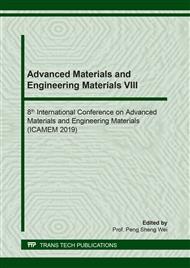[1]
S.C. Chen, C.C. Wan, Y.Y. Wang. Thermal analysis of lithium-ion batteries. Journal of Power Sources. 2005, 140, 111-124.
DOI: 10.1016/j.jpowsour.2004.05.064
Google Scholar
[2]
A. Jarrett, I.Y. Kim. Design optimization of electric vehicle battery cooling plates for thermal performance. Journal of Power Sources. 2011, 196, 10359-10368.
DOI: 10.1016/j.jpowsour.2011.06.090
Google Scholar
[3]
H. Park. A design of air flow configuration for cooling lithium ion battery in hybrid electric vehicles. Journal of Power Sources. 2013, 239, 30-36.
DOI: 10.1016/j.jpowsour.2013.03.102
Google Scholar
[4]
Z. Rao, S. Wang, G. Zhang. Simulation and experiment of thermal energy management with phase change material for ageing LiFePO4 power battery. Energy Conversion and Management. 2011, 52, 3408-3414.
DOI: 10.1016/j.enconman.2011.07.009
Google Scholar
[5]
N. Sato. Heat behavior analysis of nickel metal hydride batteries for electric vehicles. Journal of Power Sources. 2001, 99, 70-77.
Google Scholar
[6]
T.-H. Tran, S. Harmand, B. Sahut. Experimental investigation on heat pipe cooling for Hybrid Electric Vehicle and Electric Vehicle lithium-ion battery. Journal of Power Sources. 2014, 265, 262-272.
DOI: 10.1016/j.jpowsour.2014.04.130
Google Scholar
[7]
R. Kizilel, A. Lateef, R. Sabbah, M.M. Farid, J.R. Selman, S. Al-Hallaj. Passive control of temperature excursion and uniformity in high-energy Li-ion battery packs at high current and ambient temperature. Journal of Power Sources. 2008, 183, 370-375.
DOI: 10.1016/j.jpowsour.2008.04.050
Google Scholar
[8]
F. Bai, M. Chen, W. Song, Z. Feng, Y. Li, Y. Ding. Thermal management performances of PCM/water cooling-plate using for lithium-ion battery module based on non-uniform internal heat source. Applied Thermal Engineering. 2017, 126, 17-27.
DOI: 10.1016/j.applthermaleng.2017.07.141
Google Scholar
[9]
D. Chen, J. Jiang, G.-H. Kim, C. Yang, A. Pesaran. Comparison of different cooling methods for lithium ion battery cells. Applied Thermal Engineering. 2016, 94, 846-854.
DOI: 10.1016/j.applthermaleng.2015.10.015
Google Scholar
[10]
C. Lin, S. Xu, G. Chang, J. Liu. Experiment and simulation of a LiFePO 4 battery pack with a passive thermal management system using composite phase change material and graphite sheets. Journal of Power Sources. 2015, 275, 742-749.
DOI: 10.1016/j.jpowsour.2014.11.068
Google Scholar
[11]
Y. Zhong, S. Li, X. Wei, Z. Liu, Q. Guo, J. Shi, L. Liu. Heat transfer enhancement of paraffin wax using compressed expanded natural graphite for thermal energy storage. Carbon. 2010, 48, 300-304.
DOI: 10.1016/j.carbon.2009.09.033
Google Scholar
[12]
D. Bernardi, E. Pawlikowski, J. Newman. A General Energy Balance for Battery Systems. Journal of the Electrochemical Society. 1984, 132, 5-12.
Google Scholar


